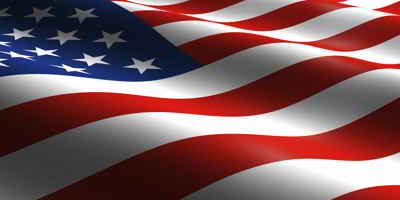

Arkansas Symbols
Arkansas State Flag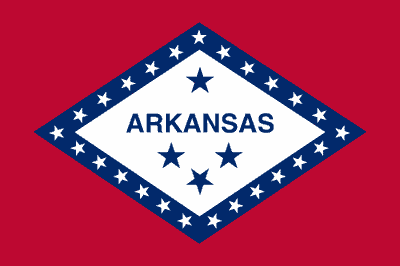
"lone star commemorate Arkansas' Confederacy membership"
Adopted on February 26, 1913.
The Arkansas state flag, designed by Miss Willie K. Hocker of Wabbaseka, Arkansas, was adopted in 1913. The 25 stars indicate that Arkansas was the 25th state admitted to the United States. The three large stars in the center stand for the three nations that have ruled Arkansas: Spain, France and the United States. Also, Arkansas was the third state formed from the Louisiana Purchase. The large star above ARKANSAS symbolizes the Confederacy which Arkansas was a part of from 1861-1865, and the diamond formed by the 25 stars represent Arkansas as the only diamond-producing state in the Union.
The Arkansas State Flag
Arkansas Flag of 1913
 Around 1912, the Pine Bluff
chapter of the Daughters of the American Revolution (DAR) wished to present a state flag for the commissioning of the battleship USS Arkansas. When it was discovered
that Arkansas did not have a state flag, the DAR chapter decided to sponsor a contest to design a flag. Hocker, a member of the Pine Bluff DAR chapter, won with a
design that is similar to the current flag. Hocker designed the flag with three blue stars in the middle of the white diamond and omitted "ARKANSAS".
Around 1912, the Pine Bluff
chapter of the Daughters of the American Revolution (DAR) wished to present a state flag for the commissioning of the battleship USS Arkansas. When it was discovered
that Arkansas did not have a state flag, the DAR chapter decided to sponsor a contest to design a flag. Hocker, a member of the Pine Bluff DAR chapter, won with a
design that is similar to the current flag. Hocker designed the flag with three blue stars in the middle of the white diamond and omitted "ARKANSAS".
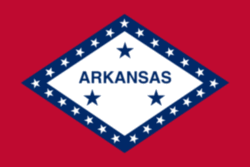 1913 Flag: At the request of the flag committee, chaired by Secretary of State Earle Hodges, Hocker added "ARKANSAS" and rearranged the stars
to one on top and two on bottom. This flag was adopted by the legislature on February 26, 1913.
1913 Flag: At the request of the flag committee, chaired by Secretary of State Earle Hodges, Hocker added "ARKANSAS" and rearranged the stars
to one on top and two on bottom. This flag was adopted by the legislature on February 26, 1913.
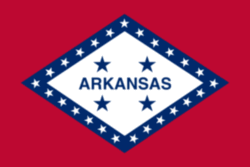 In 1923, the legislature added
a fourth star, representing the Confederate States of America. This fourth star was originally placed so that there were two stars above the state name and two below;
this was to include the Confederacy alongside Spain, France, and the United States. Since this disturbed the other two meanings of the original three stars, the
legislature corrected this in 1924 by placing the Confederate star above "ARKANSAS" and the original three stars below it, as it is today.
In 1923, the legislature added
a fourth star, representing the Confederate States of America. This fourth star was originally placed so that there were two stars above the state name and two below;
this was to include the Confederacy alongside Spain, France, and the United States. Since this disturbed the other two meanings of the original three stars, the
legislature corrected this in 1924 by placing the Confederate star above "ARKANSAS" and the original three stars below it, as it is today.
In 2001, a survey conducted by the North American Vexillological Association (NAVA) placed the Arkansas state flag 45th in design quality out of the 72 Canadian provincial, U.S. state, and U.S. territory flags ranked.
In 2011, Act 1205 (formerly House Bill 1546) was signed by Governor Beebe adding some more details to the state flag. In the terms of colors, the red
and blue used on the state flag is Old Glory Red and Old Glory Blue. The Act also stated that flags purchased by the Secretary of State must be manufactured in the
United States.
History and Meaning of the Arkansas Flag
Can you imagine Arkansas' flag with an ocean steamer or a dancing bear? Instead of the handsome and dignified red flag centered with a diamond and stars, such flags could have flown over the twenty-fifth state if a 1913 committee had not acted with wisdom.
The battleship USS. Arkansas was to be commissioned and the Pine Bluff chapter of the Daughters of the American Revolution voted to present a state flag to the ship. But first, the flag committee of the chapter had to learn about the state flag. A letter to the Secretary of State Earl W. Hodges was sent by a committee of three, Mrs. C. W. Pettigrew (whose idea it was in the first place), Mrs. W. A. Taggart and Mrs. Frank Tomlinson. Before long they had the answer: there was no state flag.
The Pine Bluff group decided to correct the situation by holding a statewide flag contest. Mr. Hodges was asked to act as custodian for entries. Sixty-five separate designs were entered in the contest. Some were crayon drawings and some were flag miniatures on silk.
As the state flower, the apple blossom appeared on a number of designs. One centered with the flower was scattered with stars representing the United States. There were thirteen rays on it for the original states and the colors were red, white and blue. One flag used just the apple blossom, four of them in colorful blocks. Another design used the outline of Arkansas and the state seal with red, white and blue.
Mr. Hodges was chairman of the committee to select the flag and he chose a distinguished list of members: Dr. Junius Jordan, the chairman of philosophy and pedagogy at the University of Arkansas; Mrs. Julia McAlmont Noel, a member of the John McAlmont Chapter of the D.A.R. in Pine Bluff; Miss Julia Warner, a teacher in the Little Rock school system, and Mrs. P. H. Ellsworth, a former president of the Arkansas Federation of Women's Clubs.
In the early days of 1913 the committee gathered in Mr. Hodges' office and worked on choosing a flag. As a winner they chose the red, white and blue design of Miss Willie Hocker of Wabbaseka, a member of the Pine Bluff chapter of the D.A.R., where the search originated.
On a rectangular field of red, Miss Hocker had placed a large white diamond bordered by twenty-five white stars on a blue band. Three blue stars in a straight line were centered in the diamond.
Miss Hocker explained that the colors in her design meant that Arkansas was one of the United States of America. The three blue stars had three meanings: Arkansas belonged to three countries (France, Spain, and the United States) before attaining statehood; 1803 was the year of the Louisiana Purchase when the land that is now Arkansas was acquired by the United States; and Arkansas was the third state created from the purchase by the United States, after Louisiana and Missouri.
The twenty-five stars mean that Arkansas was the twenty-fifth state to be admitted to the Union. The diamond represents Arkansas as the nation's first diamond-producing state. The two parallel white stars at the left and right points of the diamond symbolize the dual admission of Arkansas and Michigan to the Union. Both were admitted to the Union about the same time-Arkansas on June 15, 1836 and Michigan on January 26, 1837.
On February 26, 1913, the legislature made Miss Hocker's design the state's official flag. The USS. Arkansas received her flag from the Pine Bluff Chapter of the DAR.
Then there was trouble...there was no indication on the flag that Arkansas had been a member of the Confederate States of America from 1861 to 1865. To correct that, the legislature in 1923 added a fourth blue star above the letter "R" in Arkansas and moved the single blue star to a position above the last "A". But, a furor arose and many claimed that the original symmetry and meaning of the design were destroyed.
So in 1924 the legislature placed three blue stars below the word "Arkansas" and one above, the way the flag is today.
The three stars below "Arkansas" retained the meanings Miss Hocker had set and the lone star above the word is to commemorate Arkansas' membership in the Confederacy.
And so it remains today...a proud banner that flies for all Arkansans.
Salute to the Arkansas Flag:
"I salute the Arkansas Flag with its diamond and stars. We pledge our loyalty to thee."
Arkansas Flag Law
Arkansas Code (Non annotated), Title 1, Chapter 4.
TITLE 1. General Provisions.
Chapter 4. State Symbols, Motto, Etc.
Section 1-4-101. State Flag.
(a) The official state flag shall be a rectangle of red on which is placed a large white diamond, bordered by a wide band of blue on which are twenty-five
(25) white stars. Across the diamond shall be the word "ARKANSAS" and four (4) blue stars, with one (1) star above and three (3) stars below the word "ARKANSAS". The star
above the word "ARKANSAS" shall be below the upper corner of the diamond. The three (3) stars below the word "ARKANSAS" shall be placed so that one (1) star shall be above
the lower corner of the diamond and two (2) stars shall be placed symmetrically, parallel above and to the right and left of the star in the lower corner of the diamond.
(b) The three (3) stars so placed are designed to represent the three (3) nations, France, Spain, and the United States, which have successively exercised
dominion over Arkansas. These stars also indicate that Arkansas was the third state carved out of the Louisiana Purchase. Of these three (3) stars, the twin stars parallel
with each other signify that Arkansas and Michigan are twin states, having been admitted to the Union together on June 15, 1836. The twenty-five (25) white stars on the
band of blue show that Arkansas was the twenty-fifth state admitted to the Union. The blue star above the word "ARKANSAS" is to commemorate the Confederate States of
America. The diamond signifies that this state is the only diamond-bearing state in the Union.
History. House Concurrent Resolution, No. 23, Acts 1953, p. 1510; A.S.A. 1947, ? 5-108.
1-4-103. Lowering of flags upon death of public officials.
(a) It shall be the policy of the State of Arkansas to honor and pay tribute to certain public officials by lowering the state flags located on public
buildings and other public property to half-mast from the time notice of the official's death is received through the day on which funeral services are conducted for the
deceased official.
(b) This section shall apply with respect to the following officers:
(1) Current and past members of the United States Congress from the State of Arkansas;
(2) Current constitutional officers of the State of Arkansas;
(3) Former Governors of the State of Arkansas;
(4) Current members of the Arkansas General Assembly;
(5) Current members of the Arkansas Supreme Court.
(c) The provisions of this section shall not interfere with or restrict the authority of the Governor to order the state flag lowered to half-mast by
executive proclamation at times other than those mentioned in this section.
History. Acts 1977, No. 534, ?? 1-3; A.S.A. 1947, ?? 5-108.1 - 5-108.3.
1-4-104. Distribution of flags.
(a) The Secretary of State is authorized and directed to obtain a sufficient quantity of flags of the United States and of the State of Arkansas in order
that the flags that have been flown over the State Capitol Building may be made available to members of the House and Senate of the General Assembly and to the Governor for
distribution to civic groups, schools, and organized youth groups in their respective areas.
(b) A sufficient quantity of flags shall be obtained to permit the Secretary of State to make available for distribution in the manner authorized in this
section:
(1) Fifteen (15) Arkansas flags and ten (10) United States flags per calendar year to each member of the House of Representatives and the Senate;
(2) One hundred (100) flags per calendar year, which may be either Arkansas flags or United States flags as indicated by the Governor, to the Governor; and
(3) Twenty-five (25) Arkansas flags and twenty-five (25) United States flags per calendar year to:
(A) The office of the Speaker of the House of Representatives;
(B) The office of the President Pro Tempore of the Senate;
(C) The Lieutenant Governor;
(D) The Secretary of State;
(E) The Treasurer of State;
(F) The Auditor of State; and
(G) The Commissioner of State Lands.
(c) The provisions of this section shall be in lieu of any other law of this state which provides for the Secretary of State to furnish copies of flags for
distribution to civic groups, schools, and organized youth groups.
History. Acts 1985, No. 414, ?? 1, 2; A.S.A. 1947, ?? 5-120, 5-121; Acts 1989 (1st Ex. Sess.), No. 123, ? 14; 2003, No. 300, ? 1.
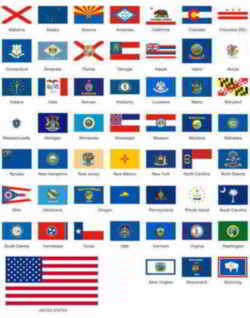
The Flags of the US.





